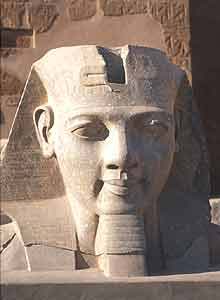Plundering the Past

Billions of dollars in looted art are sold each year
by David Johnson |
 The head of Ramses II was stolen by thieves with an electric saw and dragged 70 miles before being recovered by Egyptian police. (Source:Arttoday) Stolen TreasuresSome examples of common stolen art:
Related Links |
REMEMBER DR. NO? He was your typical movie villain: notorious, wealthy, and a fine art connoisseur. Unfortunately for art enthusiasts, unscrupulous millionaires like Dr. No aren't just silver screen fantasies. They're real people willing to pay huge sums for art, no questions asked.
A recently released report by the McDonald Institute for Archaeological Research in the University of Cambridge, England, states that up to $3 billion in art and artifacts are stolen each year around the world.
The authors claim that up to 90 percent of the antiquities auctioned in London—one of the world's leading art markets—contained no details of origin. Leading art dealers, however, have vigorously denied knowingly handling smuggled or stolen works. Britain has been urged to follow the lead of the U.S. and sign the 1970 UNESCO convention forbidding the illegal import or export of artifacts.
Stealing History
Titled Stealing History: The Illicit Trade in Cultural Material, the report charges that art and antiquities are being stolen from archaeological sites, museums, churches, and libraries in record amounts. With the aid of organized crime syndicates, corrupt government officials, and compliant art dealers, these plundered treasures are finding their way onto the booming international market, which is flush with collectors willing to shell out record sums of money.
Art thefts have a cultural impact. Because entire archaeological sites are being plundered, scholars are losing valuable clues to the past. Experts point out that some ethnic peoples, especially in Africa and the Americas, may never be able to fully learn about the life and the religion of their ancestors.
Dr. No Meets Miami Vice
Miami is singled out as the center of the illegal international art market by the report. A natural destination for artwork from Latin America, Miami attracts treasures from all over the world. The report says this may be because of the huge amount of drug money circulating in the city.
Experts say that collectors with large sums of "dirty" money can pay cash for valuable antiquities from unscrupulous dealers. It is a system that benefits middlemen far more than those who did the actual looting. For instance, a looter may sell Mayan ceramics stolen from a remote jungle site for $200 to $500. The final buyer may pay $100,000 for the same items.
Recommendations to a More Open Art Market
Scholars urge that auction houses and art dealers refuse to handle objects without accompanying documentation on previous owners. There is a good chance these items may have been looted. They also hope experts will not appraise art with a questionable past.







